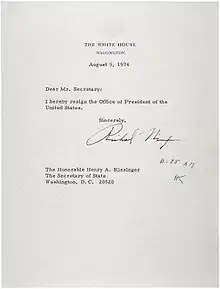Letter of resignation
A letter of resignation is written to announce the author's intent to leave a position currently held, such as an office, employment or commission.

Such a letter will often take legal effect to terminate an appointment or employment, as notice under the relevant terms of the position; many appointments and contractual employments are terminable by unilateral notice, or advance notice of a specified period of time, with or without further conditions. Even where an oral notice would be effective, the effective date or time of termination may be directly or indirectly fixed on delivery of a written letter or email, for the sake of clarity and record. In response, different arrangements may be made or agreed, such as an earlier effective date, or improved terms and conditions of appointment upon withdrawal of the letter.
Historical
A formal letter with minimal expression of courtesy is then-President Richard Nixon's letter of resignation under the terms of a relatively unknown law passed by Congress March 1, 1792,[1] likely drafted in response to the Constitution having no direct procedure for how a president might resign. Delivered to then-Secretary of State Henry Kissinger on 9 August 1974, it read simply, "I hereby resign the Office of President of the United States." It was simply dated, but Kissinger also recorded upon it the time of receipt.
References
- Richard M. Nixon’s Resignation Letter, 08/09/1974 Description of letter at US National Archives
| Wikimedia Commons has media related to Letters of resignation. |